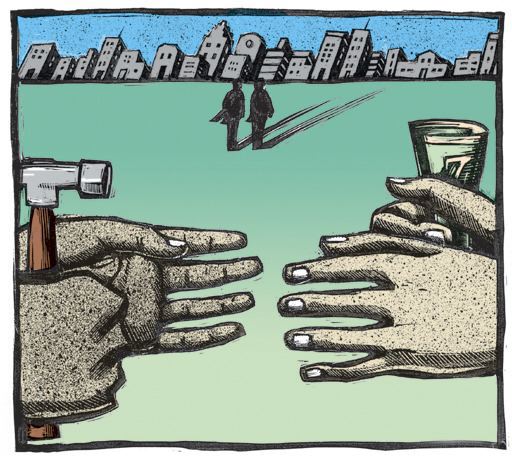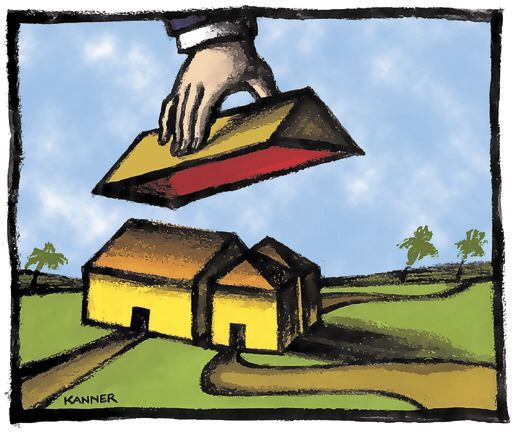
|

Opinion: A DEVELOPING SCAM: Bureaucrats, lobbyists behind housing requirement

|
||
|
|
||
|
|
||

|
||
|
|
||
|
|
||

|
||
|
|
||
|
|
June 17, 2007 9:18 AM
While watching a recent county Board of Supervisors meeting, I was amazed to observe how much confusion still exists between our supervisors and county staff over state-mandated housing issues.
The confusion stems from the state of California's requirement that the county rezone acreage in the unincorporated areas to create additional low and very low income housing. This is in order to complete the state's certification of the housing element of the county's general plan.
When bureaucrats at the state Department of Housing and Community Development reviewed the county's housing element, they concluded that the county was sufficient in housing numbers in all income categories other than for very low and low income citizens, and that the county needed to rezone land for an additional 1,235 units for those two income groups. To accomplish the task, the state told the county it must rezone 62 acres of land at a minimum density of 20 units per acre.
The 20-unit-per-acre requirement exists because of a scam perpetrated upon us all by development interests in Sacramento. Building industry lobbyists convinced our state legislators and regulators that if they would just require counties to rezone land at a minimum density of 20 units per acre, developers could and would produce "affordable housing by design," although there would be no legal requirement for them to sell units at prices obtainable by citizens in any of the required affordable income categories.
What a joke. Everyone, especially the development community, knows it is impossible for private developers and land owners to produce very low and low income housing given the high price of land and construction along the California coast.
Low income wage earners are categorized as a family of four who earn between 50 percent and 80 percent of the county's median income. Very low income is categorized as families of four earning less than 50 percent of median income. With a county median income in Santa Barbara of around $67,000, very low income would equate to families of four earning less than $33,500 and low income would be families of four earning between $33,500 and $53,600.
Using HUD guidelines of 25 percent of monthly income going for a family's housing expense, very low income families can pay up to $698 per month for housing with low income families spending a maximum of $1,117 per month.
These numbers represent families on the upper end of the low and very low income categories. Obviously, those families toward the bottom end would have to spend a lot less. On a for-sale basis, for very low and low income families to qualify under these rules, condos would have to be sold at approximate maximum prices between $100,000 and $175,000 and rentals priced at a maximum of $698 to $1,117 per month, respectively. With new construction, without massive government subsidies, this is impossible.
If the supervisors rezone property for private land owners and developers at 20 units per acre to meet the state's recommendations, the county will end up with predominantly market-rate projects with condos selling at over $750,000. There will be little or no housing for very low or low income groups, but instead there will be outrageous windfall profits for those lucky landowners and developers whose properties are selected for rezoning.
Agricultural land on the South Coast can sell for approximately $100,000 to $200,000 per acre. If rezoned for market-rate condos at 20 units per acre, that same land could then be worth as much as $2 million to $4 million per acre, depending on location. Given a 10-acre parcel, its value could jump from $1 million to $2 million up to $20 million to $40 million.
If the supervisors implement rezoning of privately owned properties under state guidelines, the only things they will have succeeded in doing is to make wealthy people richer and add traffic, congestion and pollution to our neighborhoods -- whose roads and other infrastructure already are nearing maximum capacity -- without accruing any benefit to the targeted income groups.
At the board meeting, Supervisor Brooks Firestone remarked that the public doesn't understand this subject. I take exception to that statement. The problem is we understand it all too well, and to use Supervisor Salud Carbajal's words during the debate, it's why the public is so "pissed off."
The solutions to the problem lie in using county lands to the extent possible to produce housing for the desired income groups. Additionally, the county can partner with respectable nonprofit organizations like Peoples Self Help Housing to build low income rental units on smaller parcels.
If the county can't meet all of the numbers for the targeted income groups, the supervisors need to tell the state they did the best they could, but they refuse to be part of the building industry's scam to develop out our communities with high-density, market-rate housing so that developers can make tens of millions of dollars.
In the end, what the public doesn't want to see is that county government participated in this hoax and then blamed it on the state, with the supervisors telling us the devil made them do it.
The author lives in the Goleta Valley.